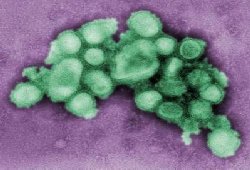Mexico struggling to find source of killer flu
29/04/2009| IslamWeb
Mexico first noticed a strange new flu virus after a woman died in the southern state of Oaxaca on April 13, but investigators are far from discovering the origin of an outbreak that has spread throughout the world.
Possible cases of the new PN1 swine flu have been found in several locations in Mexico hundreds of miles apart from as early as mid-March, complicating the search for the source of the epidemic that his killed more than 150 people in Mexico.
The flu, a novel mixture of DNA from avian, swine and human viruses, appeared in Mexico in recent weeks in Oaxaca, Veracruz near the Gulf Coast, Baja California on the U.S. border and the central state of San Luis Potosi.
And independently of the cases that Mexican doctors began to see, two children in California became sick with what later turned out to be swine flu at the end of last month.
"Where did the virus come from? We don't know. Did someone come from California or did someone go from Mexico to California? We don't have that information," Health Minister Jose Cordova said.
Many of the confirmed swine flu cases in Mexico and the United States are genetically identical, the World Health Organization says.
Experts say the illness likely emerged in a pig infected with avian and human flu strains.
"At some point someone in a rural area came into contact with a pig that was infected, or as it was transported, or at a slaughterhouse," said Dr Joan Nichols of the University of Texas Medical Branch.
Mexico pigs
Even if the virus were traced to a pig in Mexico, it might have been imported from the United States. Mexico is the world's biggest importer of U.S. hogs.
All the deaths have been in Mexico, which could indicate that the illness emerged there, Nichols said.
Mexican authorities began to look closely at the outbreak after the death of the woman in Oaxaca, which they initially thought was due to a coronavirus, the same family of viruses that includes the SARS virus, rather than influenza.
Among the cases later discovered was a large influenza outbreak near Perote, a small town in Veracruz state, which was reported on April 2.
The presence nearby of a giant pig farm operated by a joint venture of a large U.S. pork processor has prompted speculation that the town is the epicenter of the epidemic.
But the Mexican government has dismissed the Perote outbreak as the source of the illness, arguing that all but one of the 20 or so victims tested positive for another type of human flu virus known as PN2. A 4-year-old boy later tested positive for the PN1 swine flu.
PHOTO CAPTION
This preliminary negative stained transmission electron micrograph (TEM) image depicts some of the ultrastructural morphology of an PN1 "swine flu" virus culture obtained from a California patient suffering from the current international flu outbreak, in an image obtained from the U.S. Centers for Disease Control (CDC) in Atlanta, April 28, 2009.
Source: Reuters
www.islamweb.net

